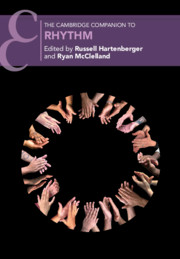Book contents
- The Cambridge Companion to Rhythm
- Cambridge Companions to Music
- The Cambridge Companion to Rhythm
- Copyright page
- Contents
- Figures
- Tables
- Music Examples
- Notes on Contributors
- Acknowledgments
- Introduction
- Part I Overview of Rhythm
- Part II Performing Rhythm
- Part III Composing with Rhythm
- Part IV Rhythm in Jazz and Popular Music
- 10 Jazz Rhythm
- 11 Rhythmic Influence in the Rock Revolution
- 12 Rhythm in Contemporary Rap Music
- Part V Rhythm in Global Musics
- Part VI Epilogue
- Select Bibliography
- Index
12 - Rhythm in Contemporary Rap Music
from Part IV - Rhythm in Jazz and Popular Music
Published online by Cambridge University Press: 18 September 2020
- The Cambridge Companion to Rhythm
- Cambridge Companions to Music
- The Cambridge Companion to Rhythm
- Copyright page
- Contents
- Figures
- Tables
- Music Examples
- Notes on Contributors
- Acknowledgments
- Introduction
- Part I Overview of Rhythm
- Part II Performing Rhythm
- Part III Composing with Rhythm
- Part IV Rhythm in Jazz and Popular Music
- 10 Jazz Rhythm
- 11 Rhythmic Influence in the Rock Revolution
- 12 Rhythm in Contemporary Rap Music
- Part V Rhythm in Global Musics
- Part VI Epilogue
- Select Bibliography
- Index
Summary
One can observe two trends in music theory and analysis in recent decades, partly in response to the criticism of New Musicology in the 1990s: increased attention to the topic of rhythm and meter and increased attention to repertoires of popular music. These two trends have been mutually reinforcing. In the 1980s and 1990s, scholars argued that engaging with popular music would push music scholarship beyond its traditional focus on pitch organization. The impetus for this expansion was popular music’s distinctive rhythms endowed by the influences (or appropriations) of the musics of the African diaspora. These rhythmic features include pervasive anticipatory syncopation, unequal and often maximally even rhythmic groupings, and a tendency toward metric saturation. Given these trends, it would seem that rap music would hold particular interest to music scholars, and indeed, the study of rap music’s sonic organization has also flourished. Yet it still stands somewhat apart, a redux of the relationship of popular music vis-à-vis classical music a generation ago: existing analytic methods (rhythmic or otherwise) are either incompatible with rap music or provide seemingly little illumination. Kyle Adams has documented some ontological reasons for this disconnect: rap music always has a texted component, but the kinds of text-music correspondences analysts find so appealing are scant. Rap music also has an instrumental component (termed “the beat”), but that beat, often with many creators and composed of disparate samples of previous recordings, synthesizers, and programmed drums, would seem not to “work toward a singular expressive purpose.”
- Type
- Chapter
- Information
- The Cambridge Companion to Rhythm , pp. 196 - 214Publisher: Cambridge University PressPrint publication year: 2020



